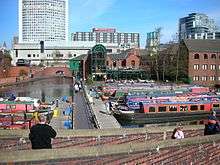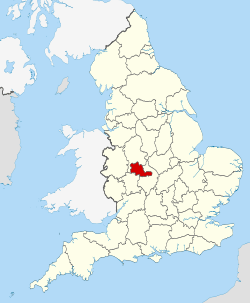Transport in Birmingham
Birmingham is a major transport hub, due in part to its location in central England. Public transport in the city is overseen by Transport for West Midlands (TfWM).
Railways
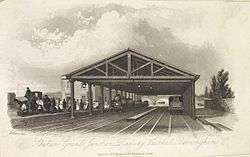
History
The first railway station to open in Birmingham was Vauxhall station, which opened in 1837 as a temporary railway shed. It served as the temporary Birmingham terminus of the Grand Junction Railway from Warrington. Curzon Street railway station opened in 1838 as the permanent terminus in the city and Vauxhall became a goods-only station until it was rebuilt and opened in 1869 under the London and North Western Railway(LNWR). The Curzon Street station remains today in its original form, designed by Philip Hardwick, mirroring his design of the Euston Arch at the London terminus of the railway line. It is Grade I listed and is the world's oldest surviving piece of monumental railway architecture. It closed to all railway traffic in 1966.[1]
New Street station opened in 1854, and Curzon Street station fell out of passenger use, running only holiday excursions for the public. New Street helped by becoming a hub for railway lines, easing connections between them. Despite this, an extension of New Street station was required in the 1880s so that Midland Railway trains between Derby and Bristol no longer needed to use Camp Hill railway station[2] which opened in 1840.[3] As of 2012 New Street station is subject to extensive modernisation and refurbishment.
.jpg)
Snow Hill station was the next major station to open in Birmingham, opening in 1852 as Livery Street station. It connected London (Paddington) to Wolverhampton Low Level. The station was rebuilt in 1871 to accommodate longer trains and again between 1906 and 1912. The latter scheme was undertaken so that the station could compete better with New Street. Other stations on the line in Birmingham were Soho and Winson Green and Hockley. To alleviate pressure on Snow Hill, Moor Street station was opened in 1909 as a terminus for the North Warwickshire lines. The two stations were linked by tunnel which closed in 1968, only to be reopened in 1987 under British Rail, when the new Moor Street station was completed. The 1960s Beeching Axe stated Snow Hill station as being unnecessary and the station closed in 1972 along with the line to Wolverhampton Low Level. The station was demolished by 1977, with only the original gates and booking hall sign surviving. However, in the 1980s, British Rail decided to re-open Snow Hill station as part of the cross-city transport plan for Birmingham. It reopened in 1987 as part of a completely redeveloped site with new office buildings replacing the original hotel, and multi-storey car parking over the station concourses. In 2011 a new station entrance was opened linking Snow Hill station to the Jewellery Quarter, on the other side of the A41 Queensway inner distribution road.
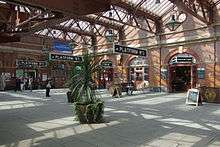
In 1986, Moor Street was relocated adjacent to the original station. However, in 2002, the original Moor Street station was renovated by the Birmingham Alliance and Chiltern Railways at a cost of £11 million, and converted into a shopping and refreshment area connected to the new platforms.
The Harborne Branch Line opened in 1875, connecting New Street to the outlying suburb of Harborne. A connection to the LNWR was created at Monument Lane. The branch terminated at Harborne railway station. The line began to suffer from falling passenger numbers, largely due to the increasing popularity of buses but also due to train delays as a result of congestion of routes at New Street station. Icknield Port Road station closed in 1931, and the other stations closed to passengers on 26 November 1934. The last passenger train to run on the line was an enthusiasts' special on 3 June 1950.The line closed to freight traffic on 4 November 1963.
In 1978 the Cross-City Line came into being, comprising the former Midland Railway line between Redditch and New Street via Selly Oak and the London and North Western Railway Line between New Street and Lichfield. It connects Sutton Coldfield, which was absorbed into Birmingham in 1974, with the Birmingham city centre. This line provides the only passenger service to Sutton Coldfield; the Sutton Park Line, opened in 1879 and closed to passengers in 1965, is still in use as a freight-only line avoiding central Birmingham.
Mainline services
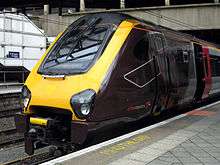
A large number of railway lines meet at Birmingham New Street railway station, which is a hub of the UK rail network and is the calling point for most intercity services to and from Birmingham.[4] Trains to London Marylebone station operated by Chiltern Railways stop at Moor Street station, and most continue to Snow Hill station.[5]
New Street Station has been redeveloped in a £500 million scheme named Gateway Plus.[6] The project improve passenger facilities and increase passenger capacity at the station, which was running at over double its capacity. The first stage of the development was completed in April 2013, when the old concourse was closed. The project was completed in 2015.[7] However, the project has met criticism from others who do not believe that the project will be effective. An alternative scheme has been suggested by Arup,[8] which would involve the construction of a new station adjacent to Moor Street Station, so that the approaches to the New Street could be improved and the station would provide better interchange facilities. The amount of land required would be very large and would also require the loss of proposed redevelopment projects in the Eastside area. The station would stretch from Moor Street to the former mainline station at Curzon Street. Arup have named the project 'Birmingham Grand Central'. The projected cost of the new station is over £500 million.[8]
High Speed 2 is to have its first spur to Birmingham (later spurs will be made to the other major cities of Leeds and Manchester). Since New Street does not have sufficient capacity for the new high-speed trains, a new dedicated high-speed railway station will be built at Curzon Street.[9] A new station called Birmingham Interchange will be opened adjacent to Birmingham International to serve the city's airport and the National Exhibition Centre (NEC).[10] The trains will run to Birmingham from London Euston.[11]
Local services
There is a network of rail services within Birmingham and the West Midlands county, operated by London Midland and supported by Transport for West Midlands (TfWM) (formerly called Centro). During 2014/15, there were nearly 51 million rail passenger journeys in the TfWM area.[12] Birmingham has the highest proportion of rail commuters in England outside London.[13] In the past few decades the proportion of journeys into central Birmingham by rail has grown sharply: 27% of journeys into Birmingham city centre in the peak hours were made by rail in 2012, compared to 17% in 2001, and 12% in 1991.[14][15]
Most of the Birmingham and West Midlands County local commuter lines are centred on New Street station, including the Cross-City Line, the Chase Line and the Coventry-Wolverhampton Line. Three commuter routes, known collectively as the Snow Hill Lines run through Snow Hill and Moor Street stations. Services are run as below:
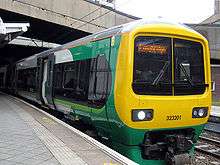
- Birmingham Loop – Wolverhampton – Birmingham New Street – Birmingham International – Coventry.
- Cross-City Line – Lichfield Trent Valley – Birmingham New Street – Longbridge – Redditch.
- Chase Line – Birmingham New Street – Walsall – Rugeley Trent Valley.
- Snow Hill Lines – Worcester – Kidderminster – Stourbridge – Birmingham Snow Hill – Birmingham Moor Street – Dorridge – / Shirley – Stratford upon Avon.
There was a regular stopping train to Leamington Spa, but this was cut back to peak only trains. Chiltern Railways took most trains over when it increased its London service, Currently CrossCountry services to Bournemoth, Reading, Southampton Central, and Guildford also call at Leamington. Arriva Trains Wales also link Birmingham International and Birmingham New Street to Wolverhampton, Shrewsbury and the Cambrian Coast Line as well as Wrexham General, Chester and stations on the North Wales Coast Line to Holyhead.
Plans are being pursued to restore local passenger services to the Camp Hill Line in southern Birmingham, which is currently freight only, by constructing new chords into Birmingham Moor Street station. This would also allow for new local services on the lines from Birmingham to Tamworth and Nuneaton.[16][17]
Midland Metro

The Midland Metro is a light-rail tram system promoted by TfWM. The system currently has one line which connects Birmingham to Wolverhampton via West Bromwich and Wednesbury. The original line from Wolverhampton to Birmingham Snow Hill station was opened in 1999. In 2016, the line was extended across Birmingham city-centre from Birmingham Snow Hill to Birmingham New Street station, it is planned to extend it further from New Street to Centenary Square and then on to Five Ways and Edgbaston, another line connecting the Eastside of the city-centre is also planned.[18] There are further plans to extend the system across Birmingham and the West Midlands.[19]
Underground system
In the early 1950s, the government planned to protect essential communications by building a series of hardened underground telephone exchanges. Construction of the Anchor exchange in Birmingham started in 1953 with a cover story that a new underground rail network was being built. Work progressed until 1956 when the public were told the project was no longer economic;[20] instead Birmingham got its underpasses through the city to help relieve congestion. An underground exchange and tunnel system 100 ft below Newhall Street had been completed at a cost £4 million. The main tunnel runs from Anchor to Midland ATE in Hill Street, from there the tunnel continued under New Street Station and on to the exchange in Essex Street.[20]
More recently, the Conservative–Lib-Dem alliance running Birmingham City Council proposed an underground system as an alternative to expansion of the Midland Metro.[21] A £150,000 feasibility study[22] was conducted, looking at the benefits and drawbacks of a state-of-the-art, £3 billion underground system serving the city.[23] Upon the outcome of the report, the city council backed plans for a street metro system.[24]
Buses and coaches
84% of public transport use in the West Midlands is by bus.[25] There are approximately 50 operators of registered local bus services in the West Midlands. The largest bus operator in the area is National Express West Midlands, which accounts for over 80% of all journeys. The company changed its name from Travel West Midlands in 2008 as a part of National Express Group's re-branding. National Express West Midlands operates a large network based on a range of services radiating out of Birmingham City Centre and the Birmingham Outer Circle bus service, the longest urban bus service in Europe[26] which chiefly follows the A4040 circular road.

Most of the network is operated on a commercial basis, with some services (usually evenings and Sundays) supported by TfWM. Smaller operators provide a range of services, either in competition with National Express West Midlands or under contract to TfWM. These include the Rotala group companies Central Connect/Blue Diamond (which is made up of the merger of Zak's,[27] North Birmingham Busways and Birmingham Motor Traction) and Diamond Bus, Central Logistics, Choice Travel (part of D&G Bus[28]) and Redwing Contracts. Medium distance bus services from Birmingham include First Wyvern (formally First Midland Red) operating services to Worcester and Redditch. Arriva operates services to Tamworth & Kingsbury in Staffordshire. Johnsons of Henley operate the longer distance bus services from the south of the conurbation such as the X20 to Stratford on Avon and the 150/X50 to Redditch. Despite the large number of buses serving Birmingham City Centre there is no longer a bus station. Instead buses terminate at bus stops on roads surrounding the city centre which are given codes assigned by area (e.g. Moor Street Interchange = MS*).[29]
The airport can also be reached via an express bus service from Coleshill Parkway station, on the Birmingham to Peterborough Line which run four times per hour and take around fifteen minutes. Alternatively, National Express West Midlands runs a regular bus service from the City Centre. The number 900 from Moor Street Queensway to Coventry runs via the airport and the National Exhibition Centre.
Birmingham is also a major hub in the National Express coach network, whose headquarters are in Birmingham. The group operates services from its hub at Birmingham Coach Station, a new coach station on the site of the former Digbeth Coach Station. A temporary coach station was located in nearby Oxford Street whilst building work was undertaken.[30] The company's flagship NXL Shuttle service operates services to London with frequent services to all major airports and cities in Britain. Many of these are cross-country services operating from north to south, for which Birmingham provides interchange facilities. Birmingham also has a Megabus service to London.
Roads
The M40 motorway connects to London via Oxford. The M6 motorway also connects Birmingham to London (via the M1) and the south, and the north-west of England and Scotland. Junction 6 of the M6 is also one of Birmingham's landmarks, and probably the most notable motorway junction in the UK, Spaghetti Junction, which is officially called the Gravelly Hill Interchange. Other motorways are:
- The A38(M) which links Spaghetti Junction to the city centre
- The M5, connecting Birmingham to the south-west of England
- The M42, which connects Birmingham to Tamworth and the East Midlands
- The M6 Toll, which enables through traffic on the M6 to bypass Birmingham and Wolverhampton.
Birmingham, unlike London and Manchester, does not have a single orbital motorway. Instead, three motorways form a box which surrounds most of the city. These are:
- The M42 which forms the southern and eastern sections. In the middle, the M40 terminates, which has its junction built with priority for traffic going from the M40 to the M42 west, instead of M42 east-west priority. The M40 goes off south to Warwick, Oxford, High Wycombe, Uxbridge and London.
- The M5 which forms the western section.
- The M6 which forms the northern section. The M5 terminates on the M6.
Other major roads passing through Birmingham include:
- The A34 from Manchester to Winchester
- The A38 from Mansfield to Bodmin
- The A41 from London to Birkenhead
- The A45 from Birmingham to Thrapston (formerly to Felixstowe)
- The A47 from Birmingham to Great Yarmouth
- The A4540 'Middleway' ring road
- The A4040 Outer Ring Road
Taxis
Black Cab taxis can be flagged down anywhere in the city or can be found waiting at designated taxi ranks in the city centre such as Broad Street, New Street, Corporation Street etc.
Private hire taxis will always need to be pre-booked as flagging one down is illegal and such journeys are not insured. There is now a dedicated website that lists a minimum of 5 Birmingham Taxi Firms for every local constituency in Birmingham. This not only ensures that you do not break the law by trying to flag a Taxi down but also keeps you safe should you find yourself stranded in the early hours.
Air
History
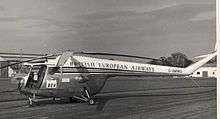
Birmingham's first airport was Castle Bromwich Aerodrome, which operated from 1909–1958. Another opened as Elmdon Airport on 8 July 1939 and continues to operate, as Birmingham Airport. A heliport operated adjacent to Baskerville House in the 1950s.
Current
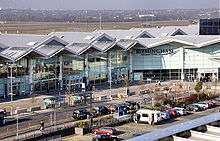
Birmingham is served by Birmingham Airport, located in the Borough of Solihull to the east of Birmingham, which is the seventh busiest (2013) by passenger traffic in the United Kingdom and has flights to a large number of European destinations such as Paris, Frankfurt, Munich, Berlin, Amsterdam, Athens, Copenhagen, Rome, Milan, Madrid, Barcelona, Reykjavik, and Istanbul as well as number of long haul services including New York City, Toronto, Orlando, Cancún, Jamaica, Dubai, Doha, Islamabad, Delhi, Amritsar and Ashgabat. Charter flights to Beijing were launched in the summer of 2014 following the completion of the runway extension. The airport is served by the railway network at Birmingham International railway station, also located in the Borough of Solihull. The airport and railway station are linked by the 585 metres (1,919 ft) long AirRail Link, originally a Maglev system but now converted to a cable-hauled SkyRail people mover. Train services are provided by either Arriva Trains Wales, Virgin Trains or London Midland on contract to TfWM.
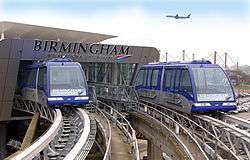
Bus services also operate from the airport to Coleshill Parkway railway station on the Birmingham – Leicester railway line. This link improves access to the East Midlands as well as providing further links to North Warwickshire and South-east Staffordshire.
The airport has 2 major bus services running into Birmingham: the 900 (Birmingham – Airport – Coventry) and the 97 (Birmingham – Airport), which operates 24 hours a day. The airport is also served by the 966 bus (Erdington – Airport – Solihull).[31] The majority of bus services from the airport are run by National Express West Midlands (formerly known as Travel West Midlands) with other various Warwickshire County Council funded services such as the 757 and 777 operating from here.
Canals
There are no navigable rivers: the Rea, on which the City was founded, is little more than a culverted stream, and the Tame, which only passes through the northern suburbs, is not navigable. The River Cole, which runs through the south-east of the city through to the north-west, is too shallow for anything bigger than a raft.
However, Birmingham is at the hub of the country's canal network. There are 35 miles (56 km) of canals within the city, of which most are navigable. Birmingham is often described as having more miles of canal than Venice. This is technically correct (Venice has 26 miles). However, Birmingham is far larger than Venice,[32] so the latter has a far higher concentration of canals; and the type of waterway is very different. Counting water volume and taking into account depth measurements, Birmingham has more cubic meters of water pass through its canals than any other city in the world.
Extensive regeneration of the canals has taken place since the 1980s, including dredging to enable the smooth passage of narrowboats and investment in and construction of canalside housing. Similar developments are planned for the Eastside area in Digbeth, and the area within Icknield Port Loop.
Canals in Birmingham include:
- The Birmingham Canal Navigations network, including the BCN Main Line and the Birmingham and Fazeley Canal
- The Worcester and Birmingham Canal
- The Grand Union Canal.
Birmingham has several reservoirs to feed its canals, including:
Public Transport Maps
Birmingham public transport maps are available from Network West Midlands as follows:
References
- ↑ "Curzon Street Station". Rail Around Birmingham and the West Midlands. Retrieved 5 July 2008.
- ↑ Pixton, B. (2005). Birmingham-Derby: Portrait of a Famous Route. Runpast Publishing.
- ↑ "Camp Hill Goods Station". Rail Around Birmingham and the West Midlands. Retrieved 5 July 2008.
- ↑ "Birmingham New Street Station Prequalification Questionnaire" (PDF). Renew Street. 2006. Archived from the original (pdf) on 28 September 2007. Retrieved 5 July 2008.
- ↑ "Route Plans 2007: West Midlands Route 17" (pdf). Network Rail. March 2007. Retrieved 5 July 2008.
- ↑ "Revealed: The new New Street station". Birmingham Post. Birmingham Post. Feb 16, 2006. Retrieved Jul 17, 2014.
- ↑ "About the development". New Street: New Start. Network Rail. Retrieved Jul 17, 2014.
- 1 2 Colin Stewart, Arup & Murray B Rayner, FRICS. "Birmingham Grand Central – Unlocking the Network" (pdf). Arup. Retrieved 5 July 2008.
- ↑ "Birmingham HS2 Curzon station plans unveiled". BBC. BBC. 27 February 2014. Retrieved 17 July 2014.
- ↑ High Speed Rail – Command Paper. London: The Stationery Office. 2010. pp. 117–118. ISBN 9780101782722.
|first1=missing|last1=in Authors list (help) - ↑ "Britain to have new national high-speed rail network". gov.uk. 10 January 2012. Retrieved 17 July 2014.
- ↑ "2015 West Midlands Travel Trends" (PDF). Centro. Retrieved 5 July 2016.
- ↑ "Tacking rail growth in the city regions." (PDF). Modern Railways. Retrieved 2 March 2013.
- ↑ "Birmingham City Council Evidence All-Party Parliamentary Group for High Speed Rail March 2012" (PDF). All-Party Parliamentary Group for High Speed Rail. Retrieved 20 September 2013.
- ↑ "Business Plan 2006 – Route 17: West Midlands – Network Rail" (PDF). www.networkrail.co.uk. Retrieved 12 March 2013.
- ↑ "Could Moseley to Birmingham trains return to end commuter hell?". Birmingham Mail. 9 June 2016. Retrieved 20 July 2016.
- ↑ "£4Bn West Midlands transport boost unveiled by council leaders". The Chamberlain Files. 15 June 2016. Retrieved 20 July 2016.
- ↑ "Terry Grimley: It's long overdue – but does it go far enough?". Birmingham Post. Retrieved 1 June 2016.
- ↑ "£322m needed for Metro extension". BBC News. 22 April 2006. Retrieved 4 August 2007.
- 1 2 "Birmingham Anchor Telephone Exchange". Subbrit. Retrieved 5 July 2008.
- ↑ "Underground idea for Birmingham". BBC News. 14 June 2003. Retrieved 4 August 2007.
- ↑ "Study on Brum underground". icBirmingham. 15 September 2004. Retrieved 4 August 2007.
- ↑ "Birmingham City Centre Underground Study" (pdf). Centro. Retrieved 5 July 2008.
- ↑ "Council support for Midland Metro expansion follows outcome of Birmingham underground study". Centro. 25 October 2005. Retrieved 4 August 2007.
- ↑ Centro: Bus Services
- ↑ Hidden Europe
- ↑ CentralConnect
- ↑ Choice Travel Services
- ↑ "Birmingham City Centre Public Transport Guide" (PDF). Retrieved 2014-07-17.
- ↑ Bus and Coach: Birmingham's coach station saga
- ↑ "By bus or coach". 2014-07-17.
- ↑ http://jquarter.members.beeb.net/walk6x.htm


_Aston_Expressway.jpg)
